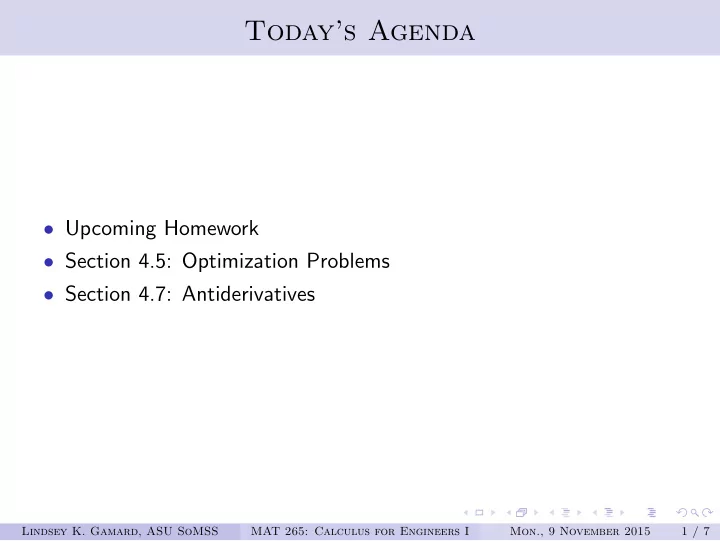

Today’s Agenda • Upcoming Homework • Section 4.5: Optimization Problems • Section 4.7: Antiderivatives Lindsey K. Gamard, ASU SoMSS MAT 265: Calculus for Engineers I Mon., 9 November 2015 1 / 7
Upcoming Homework • WeBWorK HW #20: Section 4.5, due 11/13/2015 • Written HW K: Section 4.3 #16,24,26,34,45. Due 11/13/2015. • WeBWorK HW #21: Section 4.7, due 11/16/2015 Lindsey K. Gamard, ASU SoMSS MAT 265: Calculus for Engineers I Mon., 9 November 2015 2 / 7
Section 4.5 Optimization problems are those that allow us to maximize or minimize a certain quantity. The following steps provide an outline of how to solve an optimization problem: 1 Understand the problem. Critically read the problem statement, and determine the knowns, unknowns, and given conditions. 2 Draw a diagram. 3 Introduce notation. Also label the diagram with the notation you have chosen. 4 Express the quantity that you are trying to maximize or minimize in terms of the other variables in the problem. 5 Find the absolute maximum or minimum value of the quantity in question. Lindsey K. Gamard, ASU SoMSS MAT 265: Calculus for Engineers I Mon., 9 November 2015 3 / 7
Section 4.5 Practice Problems 1 Find the area of the largest rectangle that can be inscribed in a semicircle of radius r . 2 Find the point on the parabola y 2 = 2 x that is closest to the point (1 , 4). 3 A man launches his boat from point A on a bank of a straight river, 3 km wide, and wants to reach point B , 8 km downstream on the opposite bank, as quickly as possible. He could row his boat directly across the river to point C and then run to B , or he could row directly to B , or he could row to some point D between C and B and then run to B . If he can row 6 km/hr and run 8 km/hr, where should he land to reach B as soon as possible? (We assume that the speed of the water is negligible compared with the speed at which the man rows.) Lindsey K. Gamard, ASU SoMSS MAT 265: Calculus for Engineers I Mon., 9 November 2015 4 / 7
Section 4.7 For the majority of the semester, we have been concerned with taking derivatives. Now we will discuss how to ”undo” the process of differentiation. Definition 4.7.1 A function F is called an antiderivative of the function f on an interval I if F ′ ( x ) = f ( x ) for all x ∈ I . Theorem 4.7.2 If F is an antiderivative of f on an interval I , then the most general antiderivative of f on I is F ( x ) + C , where C is an arbitrary constant. (The set { F ( x ) + C | C ∈ R } is often called the family of antiderivatives for f .) Lindsey K. Gamard, ASU SoMSS MAT 265: Calculus for Engineers I Mon., 9 November 2015 5 / 7
Section 4.7 Let’s find general antiderivatives for each of the following common functions: 1 f ( x ) = x n 2 f ( x ) = 1 x 3 f ( x ) = e x 4 f ( x ) = cos x 5 f ( x ) = sin x 6 f ( x ) = sec 2 x 7 f ( x ) = sec x tan x 1 8 f ( x ) = √ 1 − x 2 1 9 f ( x ) = 1 + x 2 Lindsey K. Gamard, ASU SoMSS MAT 265: Calculus for Engineers I Mon., 9 November 2015 6 / 7
Section 4.7 Complete the following problems with a partner. Find a general antiderivative of each of the following functions: 1 f ( x ) = 8 x 9 − 3 x 6 + 12 x 3 √ x 2 + x √ x 2 f ( x ) = 3 3 f ( t ) = 3 t 4 − t 3 + 6 t 2 t 4 4 f ( θ ) = sec θ tan θ − 2 e θ 5 f ( x ) = 2 √ x + 6 cos x 6 f ( x ) = 2 + x 2 1 + x 2 (Hint: write the numerator as 1 + (1 + x 2 ).) Lindsey K. Gamard, ASU SoMSS MAT 265: Calculus for Engineers I Mon., 9 November 2015 7 / 7
Recommend
More recommend